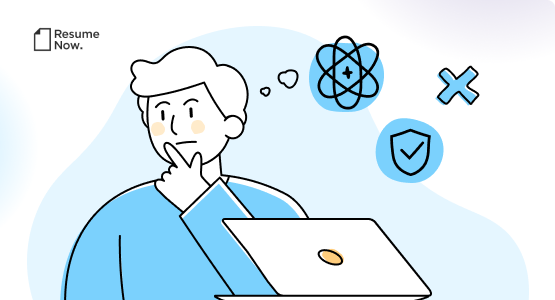Table of contents
When Sarah applied for her first job as an electrical engineer, she was nervous. She had the skills, but she needed a way to show them off. Her well-crafted cover letter made all the difference, showcasing her precision and passion for engineering.
When your electrical engineering career is ready to light up, a well-written cover letter might be just what you need to get started. You’ve come to the right place to learn exactly how to do it.
In this guide, we’ll cover:
- Popular electrical engineering cover letter examples.
- Choosing a cover letter template for the engineering field.
- Clear, step-by-step instructions for each section.
- Additional resources to ensure your application stands out.
Ready to power up your cover letter? Our Cover Letter Generator can be your guide. Choose from a range of professional styles, avoid formatting issues and use our industry-specific phrases and tips to make your application shine.
Popular electric engineering cover letter example
Before we get to the writing guide, let’s look at a perfect electrical engineering cover letter example:
How to write a cover letter for an electrical engineering job
Let’s go over the essential elements of crafting an effective electrical engineering cover letter. Even if you’re familiar with the basics of cover letter writing, honing in on these specifics can make your application stand out and clearly showcase your skills.
Step 1
Choose the right design
Select a cover letter template that mirrors the precision of the electrical engineering field and aligns with the ethos of the company you’re targeting.
Your cover letter should reflect the meticulous standards of the engineering industry, whether it’s a sleek, modern design for an innovative tech company or a more classic format for a traditional engineering firm.
Use a clean, professional font like Calibri or Times New Roman. Think of your layout as a circuit diagram — neat, organized and functional.
Step 2
Organize your header
Make sure your contact details are prominently displayed at the top of your cover letter, like the essential components on a circuit board. Include the following:
- Your full name and any relevant credentials (e.g., P.E., PMP).
- City and state.
- Phone number.
- Email address.
- LinkedIn profile or any engineering-specific profiles (e.g., IEEE membership).
Double-check your contact information for accuracy. A small error here could disrupt your connection with a potential employer!
Step 3
Address the hiring manager directly
Begin your cover letter with a greeting that sparks interest. Address the hiring manager directly with a salutation like “Dear Dr. Tesla” or “Greetings, Ms. Ohm.” If you can’t find a specific name, “Dear Hiring Manager” or “Dear [Company Name] Hiring Team” is also acceptable.
If you can’t find the hiring manager’s name, try checking the company’s website or networking on professional platforms like LinkedIn. Demonstrating your ability to troubleshoot and find solutions shows you’re already thinking like an electrical engineer.
Step 4
Capture attention in the opening paragraph
Begin your cover letter by introducing yourself and sharing your passion for electrical engineering. This is your chance to create a potential difference between you and other candidates by connecting your enthusiasm for innovation with the company’s cutting-edge projects.
Begin with a brief anecdote about a DIY electronics project or a moment of inspiration from a groundbreaking technology. This helps to conduct your enthusiasm and sets the frequency for your letter.
Step 5
Amplify your achievements
Use two to three paragraphs to detail your work history and the impact you’ve made in each role.
Specificity is key — mention the projects you’ve powered through, the systems you’ve designed and any significant technical hurdles you’ve overcome. Demonstrate how these experiences have readied you for the position you’re applying for.
Quantify your impact. Instead of saying “improved circuit efficiency,” say “designed a power supply that increased energy efficiency by 30% while reducing component costs by 15%.”
Step 6
List your most relevant skills
Engineers have the reputation of focusing primarily on their technical know-how, but the truth is soft skills can make a good engineer great. Your cover letter should have a mix of hard and soft skills.
Emphasize your technical skills, such as circuit design, power systems analysis and proficiency with engineering software. Then, add your soft skills like problem-solving, teamwork and communication.
Illustrate your skills with real-world applications. For instance, describe how your innovative thinking led to a patent-pending design or how your leadership transformed a struggling project into a success.
Step 7
End on an enthusiastic note
The close of your letter should express your excitement about potentially joining their team and thank the hiring manager for considering your application. Highlight why this particular company resonates with your career goals.
Reference a specific project or technology the company is working on that aligns with your interests. For example, “I’m particularly excited about your work on developing next-generation semiconductor materials and would love to contribute to pushing the boundaries of what’s possible in this field.”
Step 8
Sign off politely
Close your cover letter with a courteous signoff like “Sincerely” or “Best regards,” followed by your name. This adds a professional touch to your application.
For digital submissions, consider including a hyperlink to your online portfolio or a relevant project demonstration. This provides an immediate way for the hiring manager to see your work in action, much like a live circuit demonstration.
resumes made with Resume Now!
More electrical engineering cover letter examples
As you progress in your career, the structure and content of your cover letter should evolve to reflect your growing expertise and innovations.
Below are a couple of examples tailored for different stages in an electrical engineer’s career, from a new graduate to a seasoned circuit maestro.
Entry-level cover letter
Why this electrical engineering cover letter works:
-
Touches on academic background
Laura highlights her strong academic performance, specifically mentioning relevant coursework and her impressive GPA of 3.8, which establishes her foundational knowledge in electrical engineering.
-
Includes practical internship experience
Laura emphasizes her hands-on experience through internships at General Electric and SolarCity, demonstrating that she has applied her academic knowledge in real-world settings.
-
Shows commitment to continuous learning
She states her commitment to continuous learning and mentions her pursuit of a project management certification, indicating her dedication to professional growth.
Experienced cover letter
Why this electrical engineering cover letter works:
-
Engaging introduction
Patrick starts with a personal story about his early fascination with electrical systems, immediately capturing the reader’s interest and setting the stage for his career narrative.
-
Highlights leadership and impact
Patrick mentions his leadership roles and quantifiable achievements, such as reducing energy consumption by 30% and saving $2 million annually at Challenge Company.
-
Aligns well with company goals
He expresses his enthusiasm for the Metropolitan Transportation Authority’s commitment to sustainability and innovation, aligning his personal and professional goals with the company’s mission.
Update your resume
Your resume is critical in securing your next position, so you’ll want to keep it updated and visually aligned with your cover letter.
Whether you’re creating a new resume or refining an existing one, our collection of resume examples can serve as an invaluable guide. These examples, written and reviewed by professional resume writers, highlight the key elements that make an electrical engineering resume stand out.
For a streamlined and effective update, consider using a AI resume builder. These tools offer prewritten skills and phrases tailored for electrical engineering roles, along with a selection of professional templates designed for any job and industry.
Key takeaways for your electrical engineering cover letter
-
Personalize your greeting
Address the hiring manager by name if possible. This shows you’ve done your research and adds a personal touch to your application.
-
Write an engaging introduction
Start with a compelling opening that captures the reader’s interest, such as a personal story or a statement of your passion for electrical engineering.
-
Align with company values
Demonstrate your understanding of the company’s mission and values. Explain why you’re excited about the opportunity and how your background aligns with the company’s goals.
-
Tailor your content
Customize your cover letter for each job application. Highlight the skills and experiences that are most relevant to the specific job you’re applying for.
-
Close on a high note
End with a strong closing statement. Express your enthusiasm for the role and your eagerness to discuss how your experience and skills can benefit the company.
Resources to help you prepare for your interview
Was this information about Electrical Engineering Cover Letter: Examples, Templates & Tips helpful? Let us know!
Don is a Certified Professional Resume Writer (CPRW) with more than 10 years’ experience creating digital content, including four years helping job seekers develop their careers. He holds an M.S. in Journalism from Northwestern University.
More resources

Side Hustles from Home: Online Jobs, Gigs and More Ideas
From freelancing to dog-walking turn your free time into inco...

11 High-Paying Jobs That Are Less Stressful AND Flexible
Leave your stress behind with a high-paying low-stress work-fr...

AI Compliance Crisis: 57% Concerned About Unclear AI Policies at Work
Resume Now examines growing concerns amongst workers regarding...

Engineering Resume: Examples, Templates & Tips for 2025
Build an engineering resume that s bound to impress recruiters...

Executive Resume: Examples, Templates + Tips
Our executive resume examples provide inspiration and guidance...

Graphic Designer Resume: Examples & Templates for 2025
Make a graphic designer resume that gets interviews in 2025. U...
